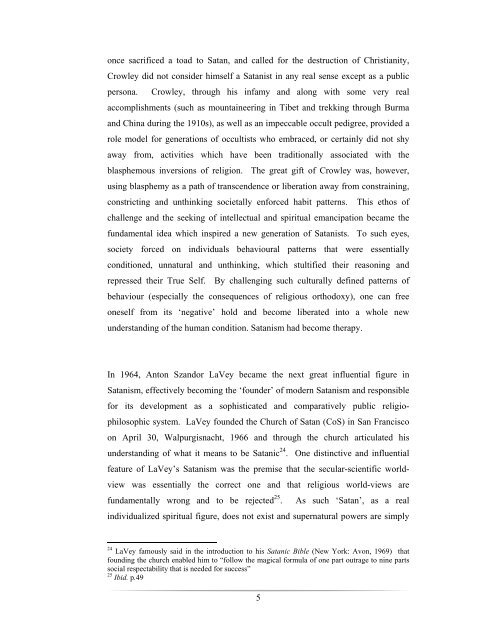Dreamers of the Dark: - Research Commons - The University of ...
Dreamers of the Dark: - Research Commons - The University of ...
Dreamers of the Dark: - Research Commons - The University of ...
Create successful ePaper yourself
Turn your PDF publications into a flip-book with our unique Google optimized e-Paper software.
once sacrificed a toad to Satan, and called for <strong>the</strong> destruction <strong>of</strong> Christianity,<br />
Crowley did not consider himself a Satanist in any real sense except as a public<br />
persona. Crowley, through his infamy and along with some very real<br />
accomplishments (such as mountaineering in Tibet and trekking through Burma<br />
and China during <strong>the</strong> 1910s), as well as an impeccable occult pedigree, provided a<br />
role model for generations <strong>of</strong> occultists who embraced, or certainly did not shy<br />
away from, activities which have been traditionally associated with <strong>the</strong><br />
blasphemous inversions <strong>of</strong> religion. <strong>The</strong> great gift <strong>of</strong> Crowley was, however,<br />
using blasphemy as a path <strong>of</strong> transcendence or liberation away from constraining,<br />
constricting and unthinking societally enforced habit patterns. This ethos <strong>of</strong><br />
challenge and <strong>the</strong> seeking <strong>of</strong> intellectual and spiritual emancipation became <strong>the</strong><br />
fundamental idea which inspired a new generation <strong>of</strong> Satanists. To such eyes,<br />
society forced on individuals behavioural patterns that were essentially<br />
conditioned, unnatural and unthinking, which stultified <strong>the</strong>ir reasoning and<br />
repressed <strong>the</strong>ir True Self. By challenging such culturally defined patterns <strong>of</strong><br />
behaviour (especially <strong>the</strong> consequences <strong>of</strong> religious orthodoxy), one can free<br />
oneself from its ‘negative’ hold and become liberated into a whole new<br />
understanding <strong>of</strong> <strong>the</strong> human condition. Satanism had become <strong>the</strong>rapy.<br />
In 1964, Anton Szandor LaVey became <strong>the</strong> next great influential figure in<br />
Satanism, effectively becoming <strong>the</strong> ‘founder’ <strong>of</strong> modern Satanism and responsible<br />
for its development as a sophisticated and comparatively public religiophilosophic<br />
system. LaVey founded <strong>the</strong> Church <strong>of</strong> Satan (CoS) in San Francisco<br />
on April 30, Walpurgisnacht, 1966 and through <strong>the</strong> church articulated his<br />
understanding <strong>of</strong> what it means to be Satanic 24 . One distinctive and influential<br />
feature <strong>of</strong> LaVey’s Satanism was <strong>the</strong> premise that <strong>the</strong> secular-scientific worldview<br />
was essentially <strong>the</strong> correct one and that religious world-views are<br />
fundamentally wrong and to be rejected 25 . As such ‘Satan’, as a real<br />
individualized spiritual figure, does not exist and supernatural powers are simply<br />
24 LaVey famously said in <strong>the</strong> introduction to his Satanic Bible (New York: Avon, 1969) that<br />
founding <strong>the</strong> church enabled him to “follow <strong>the</strong> magical formula <strong>of</strong> one part outrage to nine parts<br />
social respectability that is needed for success”<br />
25 Ibid. p.49<br />
5
















